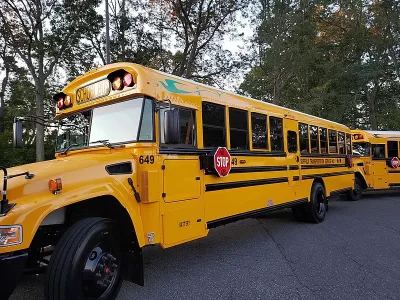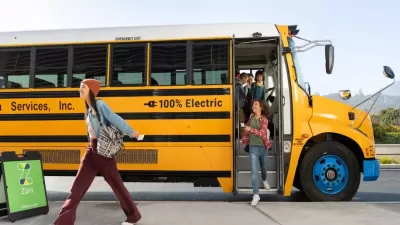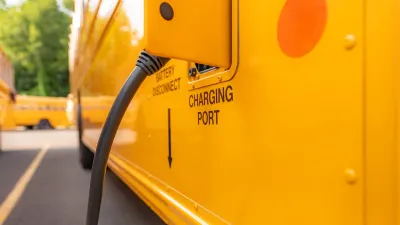A “vehicle to grid” pilot program in a Southern California school district has school buses doing double-duty as electricity storage.

“A fleet of electric-powered school buses in El Cajon can send electricity back to California's grid, thanks to first-of-its kind technology developed by a local company and a partnership with San Diego Gas & Electric,” reports Rob Nikolewski for The San Diego Union-Tribune and republished in Governing. The concept is called “vehicle to grid,” making the buses multi-task as energy storage.
Nicknamed V2G for short, the bi-directional technology allows electric vehicle batteries that charge during the day when solar energy is abundant on California's power system to then discharge emissions-free energy back to the electric grid when it is needed the most.
The El Cajon project, deployed earlier this month, is the first of its kind in the United States. “Scott Buxbaum, the school district's assistant superintendent of business services, said the buses typically charge overnight when electricity prices are low. After the buses pick up and drop off students and drivers complete other chores, the batteries quickly get recharged and can then send electricity back to the grid.” The buses charge fully in two to three hours.
The school district could even create revenue by participating in San Diego Gas & Electric’s Emergency Load Reduction Program, which “pays business customers $2 per kilowatt-hour if they are able to export power to the grid or reduce their usage during energy emergencies.”
FULL STORY: California Town’s EV School Buses Return Electricity to the Grid

Maui's Vacation Rental Debate Turns Ugly
Verbal attacks, misinformation campaigns and fistfights plague a high-stakes debate to convert thousands of vacation rentals into long-term housing.

Planetizen Federal Action Tracker
A weekly monitor of how Trump’s orders and actions are impacting planners and planning in America.

San Francisco Suspends Traffic Calming Amidst Record Deaths
Citing “a challenging fiscal landscape,” the city will cease the program on the heels of 42 traffic deaths, including 24 pedestrians.

Defunct Pittsburgh Power Plant to Become Residential Tower
A decommissioned steam heat plant will be redeveloped into almost 100 affordable housing units.

Trump Prompts Restructuring of Transportation Research Board in “Unprecedented Overreach”
The TRB has eliminated more than half of its committees including those focused on climate, equity, and cities.

Amtrak Rolls Out New Orleans to Alabama “Mardi Gras” Train
The new service will operate morning and evening departures between Mobile and New Orleans.
Urban Design for Planners 1: Software Tools
This six-course series explores essential urban design concepts using open source software and equips planners with the tools they need to participate fully in the urban design process.
Planning for Universal Design
Learn the tools for implementing Universal Design in planning regulations.
Heyer Gruel & Associates PA
JM Goldson LLC
Custer County Colorado
City of Camden Redevelopment Agency
City of Astoria
Transportation Research & Education Center (TREC) at Portland State University
Jefferson Parish Government
Camden Redevelopment Agency
City of Claremont





























